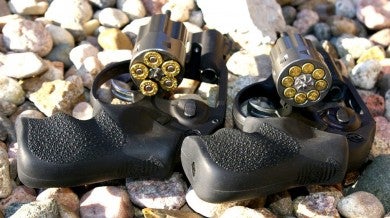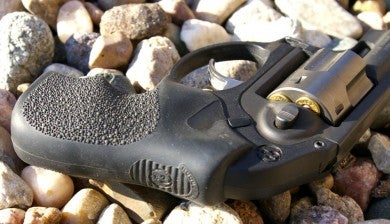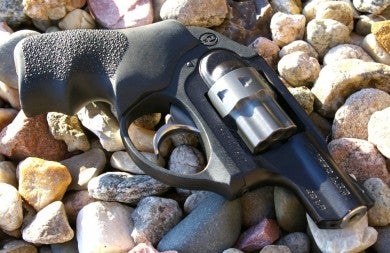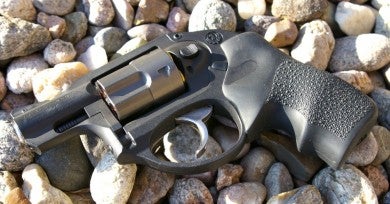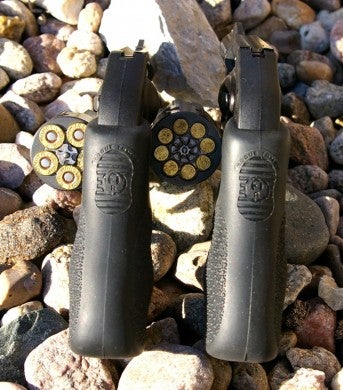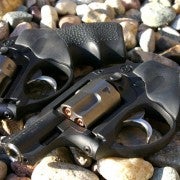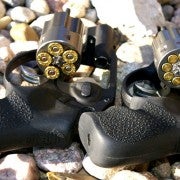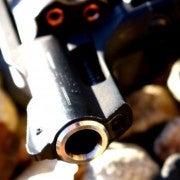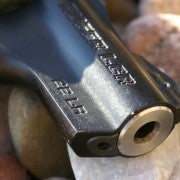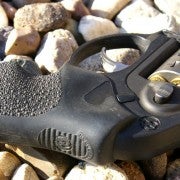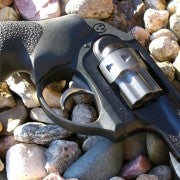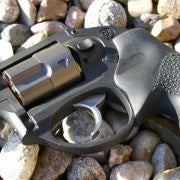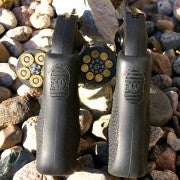Ruger LCR-357 LCR-22
Major Pandemic 12.26.13
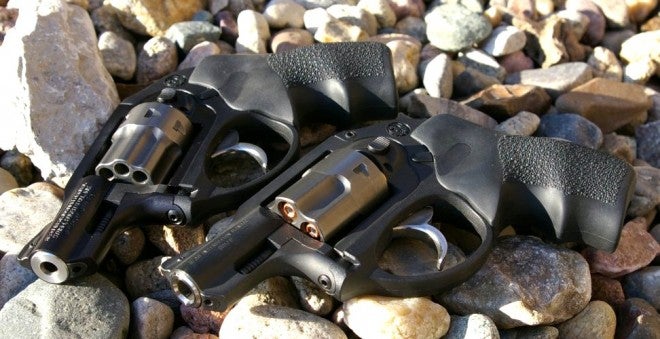
Oh how guns have changed. Back when I was a kid, if someone suggested plastic on a pistol, they were looked at strangely. If you would have suggested a polymer based revolver, well you were a special kind of stupid. Although Glock initially broke through the polymer barrier for semi-auto pistols, it is Ruger who has crossed the river of skepticism for Polymer revolvers with their LCR (Lightweight Compact Revolvers) line.
Thumbing through gun magazines and watching the stream of Outdoor network programing recently, I chuckled when I saw the same old vocal Glock skeptics of the late 70s and early 80s now waxing over the Ruger LCR polymer framed revolvers. Times have changed and minds have been opened to the benefits of new manufacturing technologies and materials, and Ruger is certainly on the bleeding edge with the LCR line. The LCRs are available in .38 Special, .357 Magnum, and now .22LR. For survival and training, the Ruger LCR-22 and KLCR-357 intrigued me with two identical revolvers chambered in my favorite calibers.
Fit and Feel
Typically Ruger does an excellent job on fit and finish, however there were a number of sharp mold flashing seams on my LCR-357 that required a couple of passes with sandpaper to smooth out. To drop the price a bit Ruger has also forgone the final surface finishing of the respective monolithic aluminum and stainless frames, though the company provides a nice matte tactical texture for this type of revolver. Both my LCRs have already seen a beating, being tossed into a pocket with other things hammering into them, so honestly I could care less about how pretty the finish looks, especially considering the revolver is solvent proof stainless, aluminum, and polymer.
The fit and feel is identical between the two Ruger LCRs, with the .357 being 17.1oz and the .22LR coming in at 14.9oz. That is crazy light in either case considering both have stainless barrels and cylinders instead of alloy. The weight of the LCR-22 splits the difference between weights. The LCR carries the lighter 7000 Series Aluminum Monolithic frame as on the 13oz .38 Special LCR versions, while the heavier LCR-357 features a stronger 400 Series Stainless Steel monolithic frame . Regardless of which LCR you have in your hand, they all provide perfect cross training analogs in weight, feel, and operation. The weight difference is not that noticeable.
This is important both from a tactical training perspective and from a confidence building perspective. For those that train constantly and own the .38 or .357 versions, the LCR-22 could pay for itself in as few as 3000 rounds while providing an identical feel to the larger caliber LCR. The LCR-22 also provides a highly reliable defensive .22LR pistol for the recoil sensitive folks, and it’s a simple transition to the .38 or .357 LCRs after they become comfortable with shooting.
Features
The LCR pistols are unique from a couple perspectives. They have hybrid polymer lower sub-frames supported by upper monolithic metal frames, with stainless lined barrels and solid heavily fluted stainless cylinders. The lower polymer sub-frame drops a considerable amount of unnecessary weight in the unstressed areas of the revolver, while the monolithic upper metal frames takes the stress of the recoil. When you combine that with a stainless barrel and cylinder, you still have a incredibly strong, reliable revolver that is almost a pound lighter than the SP101 line.
As the concealed hammer would portray, the LCR is primarily a lean and mean personal defense revolver. However, Ruger wanted to assure the trigger pull did not suffer, so they developed a friction reducing cam which resulting in a incredibly smooth non-stacking trigger pull. The trigger on the LCR-357 and .38 version are probably the best of any snubby. All the neat-o polymer and monolithic frame stuff aside, it is the trigger that steals the show for the LCR and makes it exceptionally accurate for a snub nosed revolver.
The LCR-22 version is eight shot, and some will whine that it does not match the five shots from the other LCRs, Well then just load five shots. For those that want to carry a light trail or defensive .22LR chambered revolver, the extra three rounds are greatly appreciated.
Ruger thankfully has started to integrate safety gun locks into their firearms, but I think they missed the functional mark on the LCR line. The LCR has an integral lock, but you need to inconveniently remove the grip and use the key to unlock the action, then presumably replace the grip and grip screw. A hole through the grip to use the key to unlock the action would been a more user friendly option, which I may implement with a drill bit. I like the integrated lock, but the supplied Ruger padlock’s shackle placed behind the trigger will render a loaded LCR safe and prove a faster, more useful lock.
Functions
Functionally, both these LCRs performed flawlessly and shot everything I stuffed into the cylinders. The LCR-22 delivered very heavy, reliable hammer strikes and deep rim crushes, which is what I would expect from a revolver positioned for defensive use. The LCR-357 was quite manageable with full .357 Magnum rounds and was a breeze to shoot with .38 Special rounds, all thanks to the great Hogue Tamer grips.
Both the LCRs need to have the triggers heavily stroked. As with any revolver, you cannot let your finger feel for the trigger reset like you do on any semi-auto, or you will just spin the cylinder at the first trigger reset — so stroke that trigger. Because of the friction reducing cam, this usually unnoticed reset cycle seemed a little more pronounced, but most folks probably will not notice it. This little annoyance only reared its head when I was shooting groups from the bench and carefully controlling the trigger.
Accuracy
The LCR-357 is exceptionally accurate, but the LCR-22 not so much. Using Hornady 125gr Critical Defense and 158gr XTP rounds, the Ruger LCR-357 consistently grouped 3”-4” at 25 yards from sandbags and could easily keep the 50 yard silhouette ringing as well off hand. My best group of the day was 2.75” at 25 yards from the 158Gr Hornadys, which I was thrilled with. At 7 yards I created one ragged hole, and all this great shooting is thanks to that smooth light trigger pull. The verdict of the LCR-357 is that it is a great shooting revolver.
The LCR-22 delivered the same 3”-4” groups as the LCR-357 did at 25, but at only 15 yards. Sand bag shots from the 25 yard line produced 5”-6” groups, which I was not particularly thrilled with. I believe the LCR-22 could be just as accurate or even more so than its big brothers, but the 2-3 lb heavier trigger pull is holding it back. If this was just a fun .22 plinking pistol, I would start tinkering with trigger springs, but for this defensive focused pistol, that would not be a great idea.
Final Thoughts
This is a great combo for training and every day carry. Both are equally spec’ed, finished, and approximately the same weight. Although the LCR-22 is less accurate, that’s ok because in only around 3000 rounds the ammo cost differential will pay for the LCR-22 quickly, and the light shooting .22 round will let you train all day without the pain. You can use the same holsters, the same draw technique, point of aim, and grip, and you can do it for about $6 for 100 rounds vs $30 for .38/.357 rounds. The LCR-22 is a solid build defensive .22LR revolver and is a smart purchase for those LCR owners that want to train.
The LCR-357 is an outstanding, accurate, concealed carry and personal defense revolver. It or the other .38 Special LCRs would be my first recommendations for someone wanting a handgun for defense.
Polymer is here to stay, and Ruger has utilized it in the right way with the LCR line to deliver light, solid, reliable, and accurate revolvers. Hundreds of rounds later, I am confident in the LCR-357, and with the LCR-22 I can continue to train inexpensively to continue to hone my skills.
Ruger LCR-22 Specs
- Model Number: 5410
- Caliber: .22 LR
- Finish: Matte Black, Synergistic Hard Coat
- Grip: Hogue® Tamer™
- Front Sight: Replaceable, Pinned Ramp
- Rear Sight: U-Notch Integral
- Barrel Material: Stainless Steel
- Monolithic Frame: 7000 Series Aluminum
- Cylinder Finish: Advanced Target Grey®
- Barrel Length: 1.875″ Overall Length: 6.50″
- Height: 4.50″
- Width: 1.28″
- Weight: 14.90 oz.
- Capacity: 8
- Twist: 1:16″ RH
- Grooves: 6
- MA Approved & Certified:No
- CA Approved: No
- Suggested Retail: $525.00
Ruger KLCR-357 Specs
- Model Number: 5450
- Caliber: .357 Mag.
- Finish: Blackened Stainless
- Grip: Hogue® Tamer™
- Front Sight: Replaceable, Pinned Ramp
- Rear Sight: U-Notch Integral
- Barrel Material: Stainless Steel
- Monolithic Frame: Blackened 400 Series Stainless Steel
- Cylinder Finish: Advanced Target Grey®
- Barrel Length: 1.875″
- Overall Length: 6.50″
- Height: 4.50″
- Width: 1.28″
- Weight: 17.10 oz.
- Capacity: 5
- Twist: 1:16″ RH
- Grooves: 6
- MA Approved & Certified: Yes
- CA Approved: Yes
- Suggested Retail: $599.00
